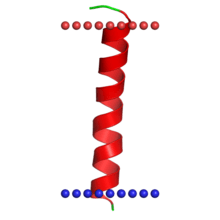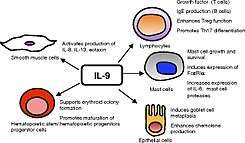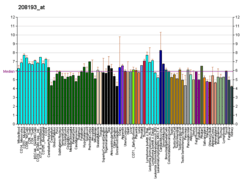Interleukin 9
Interleukin 9, also known as IL-9, is a pleiotropic cytokine (cell signalling molecule) belonging to the group of interleukins.[5] IL-9 is produced by variety of cells like mast cells, NKT cells, Th2, Th17, Treg, ILC2, and Th9 cells in different amounts. Among them, Th9 cells are regarded as the major CD4+ T cells that produce IL-9.[6]
Functions
Il-9 is a cytokine secreted by CD4+ helper cells that acts as a regulator of a variety of hematopoietic cells.[7] This cytokine stimulates cell proliferation and prevents apoptosis. It functions through the interleukin-9 receptor (IL9R), which activates different signal transducer and activator (STAT) proteins namely STAT1, STAT3 and STAT5 and thus connects this cytokine to various biological processes. The gene encoding this cytokine has been identified as a candidate gene for asthma. Genetic studies on a mouse model of asthma demonstrated that this cytokine is a determining factor in the pathogenesis of bronchial hyperresponsiveness.[5]
Interleukin-9 has also shown to inhibit melanoma growth in mice.[8]
Additionally, it gives rise to the multiplication of hematologic neoplasias and also Hodgkin's lymphoma in humans but IL-9 also has antitumor properties in solid tumors,for example melanoma.[6]
Discovery
IL-9 was first described in the late 1980s as a member of a growing number of cytokines that had pleiotropic functions in the immune system.IL-9 remains an understudied cytokine even though it has been allocated with many biological functions.It was first purified and characterized as a T cell and mast cell growth factor and termed as P40, based on their molecular weight, or Mast cell growth-enhancing activity (MEA).The cloning and complete amino acid sequencing of P40 disclosed that it is structurally different from other T cells growth factors. So, it was named IL-9 based on its biological effects on both myeloid and lymphoid cells.[9]
The identification and cloning was first done by Yang and colleagues as a mitogenic factor for a human megakaryoblastic leukemia. The same human cDNA was isolated again by cross-hybridization with the mouse IL-9 probe.[10]
Gene location
The human IL-9 gene is located on the long arm of human chromosome 5 at band 5q31-32, a region which is not found in a number of patients with acquired chromosome 5q deletion syndrome.[11]
Protein structure
Human IL-9 protein sequence contains 144 residues with a typical signal peptide of 18 amino acids. There is also the presence of 9 cysteines in mature polypeptide and 4 N-linked glycosylation sites.[10] Until recently, IL-9 was thought to be evolutionary related to IL-7.[12] However, we know now that IL-9 is closer to IL-2 and IL-15 than to IL-7,[13] at both the tertiary and amino acid sequence levels.
Production
Interleukin 33 (IL-33) induces IL-9 expression and secretion in T cells, which was confirmed by the results obtained in mice by using Human in vitro system.[14] Whereas the report of others confirms that TGF-β is an essential factor for IL-9 induction.[15] For the first time (Lars Blom,Britta C. Poulsen,Bettina M. Jensen,Anker Hansen and Lars K. Poulsen published a journal online in 2011 Jul 6),indicating that TGF-β may be important for production of IL-9 but it is not only the definite requirement for IL-9 induction, since cultures with IL-33 without TGF-β have noticeably increased secretion of IL-9, suggesting an important role of IL-33, even though that the effect was not found significant on the gene level.[16]


IL-9 expression
The analysis of IL-9 expression in different types of tumours such as Large cell anaplastic lymphoma (LCAL) and Hodgkin's Disease (HD) by Northern blot analysis and in situ hybridization has showed that IL-9 is not involved as an autocrine growth factor in the pathogenesis of most B and T-cell lymphomas, but it may have a part in HD and LCAL autocrine growth.
The further investigation could be done to conclude another probability, that, the in vivo overexpression of IL-9 might show the unique symptoms related to eosinophilia which was recently reported for Interleukin 5 positive cases of HD.[17]
IL-9 was found to be the first physiological stimulus triggering BCL3 expression in T cells and mast cells by the analysis done in mouse.[18]
References
- GRCh38: Ensembl release 89: ENSG00000145839 - Ensembl, May 2017
- GRCm38: Ensembl release 89: ENSMUSG00000021538 - Ensembl, May 2017
- "Human PubMed Reference:". National Center for Biotechnology Information, U.S. National Library of Medicine.
- "Mouse PubMed Reference:". National Center for Biotechnology Information, U.S. National Library of Medicine.
- "Entrez Gene: IL9 interleukin 9".
- Rojas-Zuleta WG, Sanchez E (2017). IL-9: Function, Sources, and Detection. Methods in Molecular Biology. 1585. pp. 21–35. doi:10.1007/978-1-4939-6877-0_2. hdl:10161/14730. ISBN 978-1-4939-6876-3. PMID 28477184.
- Perumal NB, Kaplan MH (2011). "Regulating IL9 transcription in T helper cells". Trends in Immunology. 32 (4): 146–50. doi:10.1016/j.it.2011.01.006. PMC 3070825. PMID 21371941.
- Purwar R, Schlapbach C, Xiao S, Kang HS, Elyaman W, Jiang X, Jetten AM, Khoury SJ, Fuhlbrigge RC, Kuchroo VK, Clark RA, Kupper TS (August 2012). "Robust tumor immunity to melanoma mediated by interleukin-9-producing T cells". Nature Medicine. 18 (8): 1248–53. doi:10.1038/nm.2856. PMC 3518666. PMID 22772464. Lay summary – medicalxpress.com.
- Goswami R, Kaplan MH (March 2011). "A brief history of IL-9". Journal of Immunology. 186 (6): 3283–8. doi:10.4049/jimmunol.1003049. PMC 3074408. PMID 21368237.
- Renauld J (1995). "Interleukin-9: Structural characteristics and biologic properties". Cytokines: Interleukins and Their Receptors. Cancer Treatment and Research. 80. Springer, Boston, MA. pp. 287–303. doi:10.1007/978-1-4613-1241-3_11. ISBN 9781461285281.
- Kelleher K, Bean K, Clark SC, Leung WY, Yang-Feng TL, Chen JW, Lin PF, Luo W, Yang YC (1991). "Human interleukin-9: genomic sequence, chromosomal location, and sequences essential for its expression in human T-cell leukemia virus (HTLV)-I-transformed human T cells" (PDF). Blood. 77 (7): 1436–41. PMID 1901233.
- Boulay, J. L.; Paul, W. E. (1993-09-01). "Hematopoietin sub-family classification based on size, gene organization and sequence homology". Current Biology. 3 (9): 573–581. doi:10.1016/0960-9822(93)90002-6. ISSN 0960-9822. PMID 15335670.
- Reche, Pedro A. (2019-02-01). "The tertiary structure of γc cytokines dictates receptor sharing". Cytokine. 116: 161–168. doi:10.1016/j.cyto.2019.01.007. ISSN 1096-0023. PMID 30716660.
- Humphreys NE, Xu D, Hepworth MR, Liew FY, Grencis RK (February 2008). "IL-33, a potent inducer of adaptive immunity to intestinal nematodes". Journal of Immunology. 180 (4): 2443–9. doi:10.4049/jimmunol.180.4.2443. PMID 18250453.
- Beriou G, Bradshaw EM, Lozano E, Costantino CM, Hastings WD, Orban T, Elyaman W, Khoury SJ, Kuchroo VK, Baecher-Allan C, Hafler DA (July 2010). "TGF-beta induces IL-9 production from human Th17 cells". Journal of Immunology. 185 (1): 46–54. doi:10.4049/jimmunol.1000356. PMC 2936106. PMID 20498357.
- Blom L, Poulsen BC, Jensen BM, Hansen A, Poulsen LK (2011-07-06). "IL-33 induces IL-9 production in human CD4+ T cells and basophils". PLoS One. 6 (7): e21695. doi:10.1371/journal.pone.0021695. PMC 3130774. PMID 21765905.
- Merz H, Houssiau FA, Orscheschek K, Renauld JC, Fliedner A, Herin M, Noel H, Kadin M, Mueller-Hermelink HK, Van Snick J (1991). "Interleukin-9 expression in human malignant lymphomas: unique association with Hodgkin's disease and large cell anaplastic lymphoma". Blood. 78 (5): 1311–7. PMID 1908723.
- Richard M, Louahed J, Demoulin JB, Renauld JC (1999). "Interleukin-9 regulates NF-kappaB activity through BCL3 gene induction". Blood. 93 (12): 4318–27. PMID 10361130.
Further reading
- Renauld JC, Houssiau F, Louahed J, Vink A, Van Snick J, Uyttenhove C (1993). Interleukin-9. Advances in Immunology. 54. pp. 79–97. doi:10.1016/S0065-2776(08)60533-7. ISBN 978-0-12-022454-8. PMID 8379467.
- Knoops L, Renauld JC (December 2004). "IL-9 and its receptor: from signal transduction to tumorigenesis". Growth Factors. 22 (4): 207–15. doi:10.1080/08977190410001720879. PMID 15621723.
- Modi WS, Pollock DD, Mock BA, Banner C, Renauld JC, Van Snick J (1991). "Regional localization of the human glutaminase (GLS) and interleukin-9 (IL9) genes by in situ hybridization". Cytogenetics and Cell Genetics. 57 (2–3): 114–6. doi:10.1159/000133126. PMID 1680606.
- Kelleher K, Bean K, Clark SC, Leung WY, Yang-Feng TL, Chen JW, Lin PF, Luo W, Yang YC (April 1991). "Human interleukin-9: genomic sequence, chromosomal location, and sequences essential for its expression in human T-cell leukemia virus (HTLV)-I-transformed human T cells". Blood. 77 (7): 1436–41. PMID 1901233.
- Holbrook ST, Ohls RK, Schibler KR, Yang YC, Christensen RD (May 1991). "Effect of interleukin-9 on clonogenic maturation and cell-cycle status of fetal and adult hematopoietic progenitors". Blood. 77 (10): 2129–34. PMID 1903074.
- Merz H, Houssiau FA, Orscheschek K, Renauld JC, Fliedner A, Herin M, Noel H, Kadin M, Mueller-Hermelink HK, Van Snick J (September 1991). "Interleukin-9 expression in human malignant lymphomas: unique association with Hodgkin's disease and large cell anaplastic lymphoma". Blood. 78 (5): 1311–7. PMID 1908723.
- Renauld JC, Goethals A, Houssiau F, Merz H, Van Roost E, Van Snick J (June 1990). "Human P40/IL-9. Expression in activated CD4+ T cells, genomic organization, and comparison with the mouse gene". Journal of Immunology. 144 (11): 4235–41. PMID 1971295.
- Renauld JC, Goethals A, Houssiau F, Van Roost E, Van Snick J (January 1990). "Cloning and expression of a cDNA for the human homolog of mouse T cell and mast cell growth factor P40". Cytokine. 2 (1): 9–12. doi:10.1016/1043-4666(90)90037-T. hdl:2078.1/11464. PMID 2129501.
- Yang YC, Ricciardi S, Ciarletta A, Calvetti J, Kelleher K, Clark SC (November 1989). "Expression cloning of cDNA encoding a novel human hematopoietic growth factor: human homologue of murine T-cell growth factor P40". Blood. 74 (6): 1880–4. PMID 2508790.
- Yin T, Keller SR, Quelle FW, Witthuhn BA, Tsang ML, Lienhard GE, Ihle JN, Yang YC (September 1995). "Interleukin-9 induces tyrosine phosphorylation of insulin receptor substrate-1 via JAK tyrosine kinases". The Journal of Biological Chemistry. 270 (35): 20497–502. doi:10.1074/jbc.270.35.20497. PMID 7544789.
- Postma DS, Bleecker ER, Amelung PJ, Holroyd KJ, Xu J, Panhuysen CI, Meyers DA, Levitt RC (October 1995). "Genetic susceptibility to asthma--bronchial hyperresponsiveness coinherited with a major gene for atopy". The New England Journal of Medicine. 333 (14): 894–900. doi:10.1056/NEJM199510053331402. PMID 7666875.
- Le Beau MM, Espinosa R, Neuman WL, Stock W, Roulston D, Larson RA, Keinanen M, Westbrook CA (June 1993). "Cytogenetic and molecular delineation of the smallest commonly deleted region of chromosome 5 in malignant myeloid diseases". Proceedings of the National Academy of Sciences of the United States of America. 90 (12): 5484–8. doi:10.1073/pnas.90.12.5484. PMC 46745. PMID 8516290.
- Demoulin JB, Uyttenhove C, Van Roost E, DeLestré B, Donckers D, Van Snick J, Renauld JC (September 1996). "A single tyrosine of the interleukin-9 (IL-9) receptor is required for STAT activation, antiapoptotic activity, and growth regulation by IL-9". Molecular and Cellular Biology. 16 (9): 4710–6. doi:10.1128/mcb.16.9.4710. PMC 231471. PMID 8756628.
- Nicolaides NC, Holroyd KJ, Ewart SL, Eleff SM, Kiser MB, Dragwa CR, Sullivan CD, Grasso L, Zhang LY, Messler CJ, Zhou T, Kleeberger SR, Buetow KH, Levitt RC (November 1997). "Interleukin 9: a candidate gene for asthma". Proceedings of the National Academy of Sciences of the United States of America. 94 (24): 13175–80. doi:10.1073/pnas.94.24.13175. PMC 24282. PMID 9371819.
- Demoulin JB, Van Roost E, Stevens M, Groner B, Renauld JC (September 1999). "Distinct roles for STAT1, STAT3, and STAT5 in differentiation gene induction and apoptosis inhibition by interleukin-9". The Journal of Biological Chemistry. 274 (36): 25855–61. doi:10.1074/jbc.274.36.25855. PMID 10464327.
- Lejeune D, Demoulin JB, Renauld JC (January 2001). "Interleukin 9 induces expression of three cytokine signal inhibitors: cytokine-inducible SH2-containing protein, suppressor of cytokine signalling (SOCS)-2 and SOCS-3, but only SOCS-3 overexpression suppresses interleukin 9 signalling". The Biochemical Journal. 353 (Pt 1): 109–116. doi:10.1042/0264-6021:3530109. PMC 1221548. PMID 11115404.
- Little FF, Cruikshank WW, Center DM (September 2001). "Il-9 stimulates release of chemotactic factors from human bronchial epithelial cells". American Journal of Respiratory Cell and Molecular Biology. 25 (3): 347–52. doi:10.1165/ajrcmb.25.3.4349. PMID 11588013.
- Toda M, Tulic MK, Levitt RC, Hamid Q (February 2002). "A calcium-activated chloride channel (HCLCA1) is strongly related to IL-9 expression and mucus production in bronchial epithelium of patients with asthma". The Journal of Allergy and Clinical Immunology. 109 (2): 246–50. doi:10.1067/mai.2002.121555. PMID 11842292.
- Pilette C, Ouadrhiri Y, Van Snick J, Renauld JC, Staquet P, Vaerman JP, Sibille Y (April 2002). "IL-9 inhibits oxidative burst and TNF-alpha release in lipopolysaccharide-stimulated human monocytes through TGF-beta". Journal of Immunology. 168 (8): 4103–11. doi:10.4049/jimmunol.168.8.4103. PMID 11937570.




